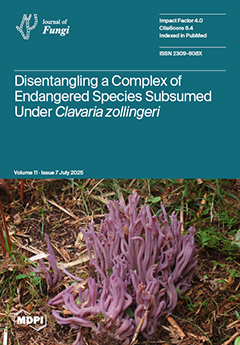Several species of
Fusarium are reported to infect inflorescences of high-THC-containing cannabis (
Cannabis sativa L.) plants grown in greenhouses in Canada. These include
F. graminearum, F. sporotrichiodes,
F. proliferatum, and, to a lesser extent,
F. oxysporum and
F. solani. The greatest concern surrounding the infection of cannabis by these
Fusarium species, which cause symptoms of bud rot, is the potential for the accumulation of mycotoxins that may go undetected. In the present study, both naturally infected and artificially infected inflorescence tissues were tested for the presence of fungal-derived toxins using HPLC-MS/MS analysis. Naturally infected cannabis tissues were confirmed to be infected by both
F. avenaceum and
F. graminearum using PCR. Pure cultures of these two species and
F. sporotrichiodes were inoculated onto detached inflorescences of two cannabis genotypes, and after 7 days, they were dried and assayed for mycotoxin presence. In these assays, all
Fusarium species grew prolifically over the tissue surface. Tissues infected by
F. graminearum contained 3-acetyl DON, DON, and zearalenone in the ranges of 0.13–0.40, 1.18–1.91, and 31.8 to 56.2 μg/g, respectively, depending on the cannabis genotype. In
F. sporotrichiodes-infected samples, HT2 and T2 mycotoxins were present at 13.9 and 10.9 μg/g in one genotype and were lower in the other. In
F. avenaceum-inoculated tissues, the mycotoxins enniatin A, enniatin A1, enniatin B, and enniatin B1 were produced at varying concentrations, depending on the isolate and cannabis genotype. Unexpectedly, these tissues also contained detectable levels of 3-acetyl DON, DON, and zearalenone, which was attributed to apre-existing natural infection by
F. graminearum that was confirmed by RT-qPCR. Beauvericin was detected in tissues infected by
F. avenaceum and
F. sporotrichiodes, but not by
F. graminearum. Naturally infected, dried inflorescences from which
F. avenaceum was recovered contained beauvericin, enniatin A1, enniatin B, and enniatin B1 as expected. Uninoculated cannabis inflorescences were free of mycotoxins except for culmorin at 0.348 μg/g, reflecting pre-existing infection by
F. graminearum. The mycotoxin levels were markedly different between the two cannabis genotypes, despite comparable mycelial colonization. Tall fescue plants growing in the vicinity of the greenhouse were shown to harbor
F. avenaceum and
F. graminearum, suggesting a likely external source of inoculum. Isolates of both species from tall fescue produced mycotoxins when inoculated onto cannabis inflorescences. These findings demonstrate that infection by
F. graminearum and
F. avenaceum, either from artificial inoculation or natural inoculum originating from tall fescue plants, can lead to mycotoxin accumulation in cannabis inflorescences. However, extensive mycelial colonization following prolonged incubation of infected tissues under high humidity conditions is required. Inoculations with
Penicillium citrinum and
Aspergillus ochraceus under these conditions produced no detectable mycotoxins. The mycotoxins alternariol and tentoxin were detected in several inflorescence samples, likely as a result of natural infection by
Alternaria spp.
Fusarium avenaceum is reported to infect cannabis inflorescences for the first time and produces mycotoxins in diseased tissues.
Full article






